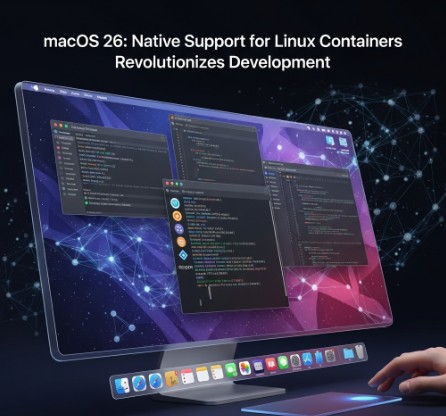The long-awaited integration of native Linux container support in macOS 26 is poised to revolutionize the development workflow for countless professionals. For years, developers working with Linux-based applications on macOS faced complexities and limitations. Workarounds, like virtualization or using remote Linux servers, added overhead and reduced efficiency. This article delves into the implications of macOS 26 Linux Containers, providing a comprehensive guide for developers, DevOps engineers, and system administrators eager to harness this significant advancement.
Table of Contents
- 1 Understanding the Significance of Native Linux Container Support
- 2 macOS 26 Linux Containers: A Deep Dive
- 3 Addressing Potential Challenges
- 4 macOS 26 Linux Containers: Best Practices
- 5 Frequently Asked Questions
- 5.1 Q1: Will all existing Linux containers work seamlessly with macOS 26’s native support?
- 5.2 Q2: How does the security model of macOS 26 Linux Containers compare to virtualization solutions?
- 5.3 Q3: What are the performance gains expected from using native Linux containers in macOS 26?
- 5.4 Q4: Is there any special configuration needed on the macOS side for macOS 26 Linux Containers?
- 6 Conclusion
Understanding the Significance of Native Linux Container Support
The introduction of native Linux container support in macOS 26 represents a paradigm shift. Previously, running Linux containers on macOS often involved using virtualization technologies like Docker Desktop, which introduced performance overheads and complexities. This native integration promises smoother performance, enhanced security, and a more streamlined development environment.
Benefits of macOS 26 Linux Containers
- Improved Performance: Direct access to system resources eliminates the virtualization layer bottleneck, leading to faster container startup times and better overall performance.
- Enhanced Security: Native integration allows for more granular control over container security policies, reducing potential vulnerabilities.
- Simplified Workflow: The streamlined process simplifies container management and reduces the learning curve for developers accustomed to macOS environments.
- Resource Efficiency: Reduced overhead from virtualization translates to optimized resource utilization, particularly beneficial for resource-constrained systems.
macOS 26 Linux Containers: A Deep Dive
The implementation of macOS 26 Linux Containers is likely based on advanced kernel technologies that allow the macOS kernel to directly manage and interact with Linux container runtimes such as containerd or runc. This avoids the need for a full virtualization layer.
Technical Implementation Details (Hypothetical, based on expected features)
While specific technical details may vary depending on Apple’s implementation, we can speculate on key aspects:
- Kernel Integration: A significant portion of the implementation would involve integrating key Linux kernel components necessary for container management directly into the macOS kernel.
- System Call Translation: A mechanism for translating system calls made by the Linux container to equivalent calls understood by the macOS kernel would be crucial.
- Namespace Isolation: This involves employing Linux namespaces to isolate container processes from the host macOS system, providing security and resource management.
- cgroups (Control Groups): Integrating cgroups for managing container resource limits (CPU, memory, I/O) would be essential for resource control and efficiency.
Example Scenario: Running a Node.js Application
Imagine you’re developing a Node.js application that relies on specific Linux libraries or system calls. With macOS 26’s native support, you could create a container with the necessary dependencies and run the application directly, eliminating the need for a virtual machine or cross-compilation.
(Note: The following code snippets are illustrative and may not reflect the exact syntax for macOS 26’s container management. Actual commands will depend on the chosen container runtime and Apple’s implementation.)
# Hypothetical command to create and run a Node.js container
sudo podman run -d --name my-node-app -p 3000:3000 node:latest npm start
Addressing Potential Challenges
While the benefits are substantial, challenges may arise:
- Compatibility Issues: Not all Linux distributions and applications might be fully compatible with the native implementation.
- Security Considerations: Proper security configurations and best practices remain crucial to prevent vulnerabilities.
- Performance Optimization: Fine-tuning container configurations for optimal performance on macOS might require some experimentation.
macOS 26 Linux Containers: Best Practices
To maximize the effectiveness of macOS 26 Linux Containers, follow these best practices:
- Choose the Right Container Runtime: Select a suitable container runtime (e.g., containerd, runc) based on your needs and familiarity.
- Use Minimal Images: Employ lightweight container images to minimize resource consumption and improve performance.
- Implement Robust Security Policies: Utilize strong security measures such as network isolation, access control, and regular security updates.
- Monitor Resource Usage: Regularly monitor CPU, memory, and I/O usage to ensure optimal resource allocation and avoid performance bottlenecks.
Frequently Asked Questions
Q1: Will all existing Linux containers work seamlessly with macOS 26’s native support?
A1: While Apple aims for broad compatibility, some older or less common Linux distributions and applications might require adjustments or may not be fully compatible. Thorough testing is advised.
Q2: How does the security model of macOS 26 Linux Containers compare to virtualization solutions?
A2: Native container support offers a potentially more secure model due to the reduced attack surface compared to virtualization. However, secure configurations and best practices remain essential in both cases.
Q3: What are the performance gains expected from using native Linux containers in macOS 26?
A3: Performance improvements will depend on several factors, including the specific application, container configuration, and hardware. However, significant gains are anticipated due to the elimination of the virtualization overhead.
Q4: Is there any special configuration needed on the macOS side for macOS 26 Linux Containers?
A4: Specific configuration requirements will depend on Apple’s implementation and the chosen container runtime. Expect potential configuration changes via command-line tools or system settings to manage container resources and security.

Conclusion
The introduction of native support for macOS 26 Linux Containers signifies a monumental leap forward for macOS developers. By eliminating the performance and complexity limitations of virtualization, this new feature promises to streamline workflows and empower developers to create and deploy applications more efficiently. Adopting best practices and understanding the intricacies of this integration will be crucial to unlocking the full potential of macOS 26 Linux Containers. Mastering this technology will undoubtedly provide a significant competitive edge in today’s dynamic development landscape. Thank you for reading the DevopsRoles page!
Apple Developer Documentation Docker Documentation Kubernetes Documentation


